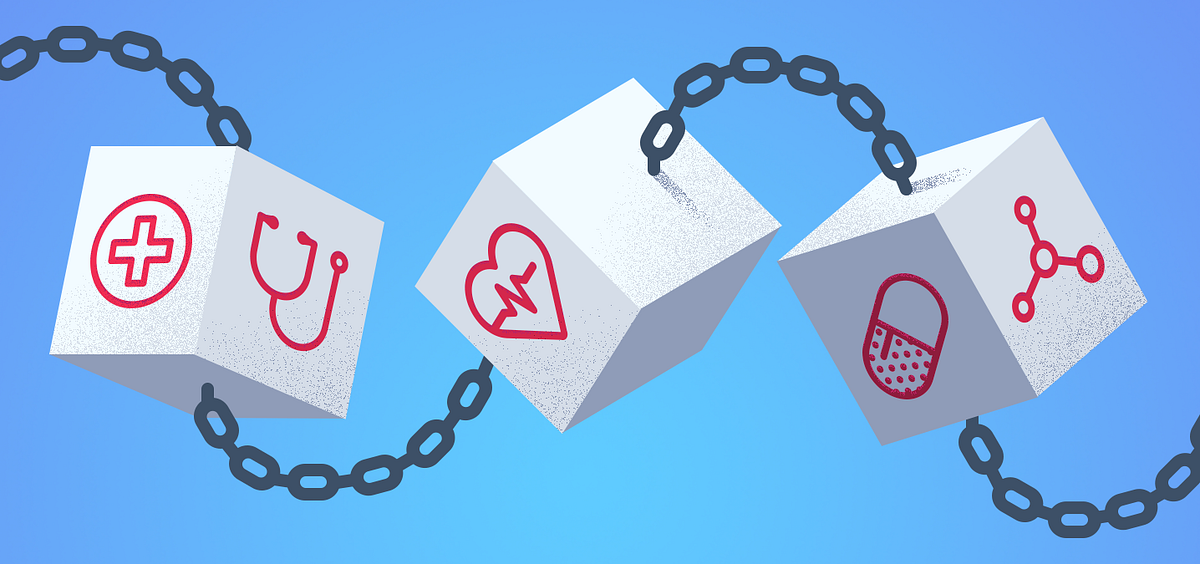The healthcare industry has long grappled with challenges in managing sensitive patient data, ensuring privacy, and improving interoperability between fragmented systems. Blockchain technology, with its robust security features and decentralized framework, is emerging as a transformative solution to these issues. This article explores how blockchain is redefining healthcare data management, its benefits, real-world applications, and the challenges it faces in widespread adoption.
1. Introduction to Blockchain in Healthcare

Blockchain is a distributed ledger technology that records transactions in a secure, transparent, and tamper-proof manner. Unlike traditional systems where data is centralized, blockchain operates on a decentralized network, making it particularly suitable for the healthcare sector where data security and privacy are paramount.
By addressing vulnerabilities in centralized systems, blockchain ensures that sensitive patient information remains secure, accurate, and accessible only to authorized parties. Its use extends beyond data security, facilitating interoperability, patient empowerment, and automated processes through smart contracts.
2. Addressing Data Security Challenges
Traditional Healthcare Data Management Problems
Healthcare data is often stored in centralized servers, making it vulnerable to breaches. A single point of failure in such systems can compromise millions of records. In recent years, several high-profile cyberattacks on healthcare institutions have underscored the need for more robust solutions.
How Blockchain Solves These Challenges
Blockchain employs a decentralized architecture where data is distributed across a network of nodes. Each transaction or update is verified by consensus, ensuring that unauthorized changes are impossible. Additionally, encryption and cryptographic keys protect patient information from unauthorized access.
For example, in 2017, Estonia implemented blockchain technology for its eHealth system, significantly enhancing the security of patient records while maintaining transparency
3. Enhancing Patient Data Ownership
In traditional models, healthcare institutions often control patient data, leaving patients with limited access and oversight. Blockchain flips this paradigm by giving patients ownership of their records. Using cryptographic keys, patients can decide who accesses their data and revoke permissions when necessary.
This approach aligns with privacy regulations like the General Data Protection Regulation (GDPR) in Europe and the Health Insurance Portability and Accountability Act (HIPAA) in the U.S. Furthermore, blockchain’s ability to create a complete audit trail builds trust and transparency, empowering patients to take an active role in their healthcare journey
4. Interoperability in Healthcare Systems
Interoperability—or the ability for different systems to exchange and interpret data—remains a significant challenge in healthcare. Fragmented systems often lead to inefficiencies, delays, and errors in patient care.
Blockchain addresses this by creating a unified, immutable ledger that all authorized participants can access. For instance, MedRec, a blockchain-based system developed at MIT, enables seamless sharing of medical records between providers while maintaining data integrity
This reduces redundancies and ensures that healthcare professionals have access to accurate, up-to-date information.
5. Ensuring Data Integrity
Blockchain’s immutability ensures that once data is entered into the system, it cannot be altered or tampered with. This is crucial in healthcare, where data accuracy can directly impact patient outcomes. By maintaining a consistent and unalterable record, blockchain eliminates the risk of fraudulent or erroneous entries.
For example, pharmaceutical companies use blockchain to monitor supply chains, ensuring that medications are genuine and have not been tampered with during distribution
6. Implementation of Smart Contracts
Smart contracts are self-executing agreements encoded on a blockchain. In healthcare, they streamline administrative tasks like insurance claims processing and patient consent management. When predefined conditions are met—such as a patient approving access to their medical records—the contract executes automatically.
This reduces manual intervention, minimizes errors, and speeds up processes. Insurance companies like Aetna and UnitedHealthcare have already started exploring blockchain for automated claims processing, showcasing its potential to revolutionize the healthcare sector
7. Real-World Applications of Blockchain in Healthcare
Blockchain’s versatility has led to its adoption in various aspects of healthcare:
- Electronic Health Records (EHRs):
Hospitals use blockchain to manage EHRs, ensuring that data is secure yet accessible to authorized providers. For instance, Seoul Medical Center in South Korea employs blockchain to improve the security and accessibility of patient records. - Pharmaceutical Supply Chain:
Counterfeit drugs are a significant issue in global healthcare. Blockchain enhances transparency in the supply chain, enabling stakeholders to verify the authenticity of medications. Companies like Pfizer have adopted blockchain solutions for this purpose. - Remote Monitoring:
Blockchain secures data generated by Internet of Things (IoT) devices, such as wearable health monitors, ensuring that only authorized individuals can access sensitive patient data
8. Challenges and Limitations

Despite its promise, blockchain faces several hurdles:
- Scalability:
As the number of transactions increases, the blockchain grows larger, potentially affecting its speed and efficiency. This is particularly challenging in healthcare, where large volumes of data are generated daily. - High Implementation Costs:
Setting up blockchain systems requires significant investment in infrastructure and expertise, which can be a barrier for smaller healthcare organizations. - Standardization Issues:
The lack of uniform standards for blockchain adoption in healthcare creates interoperability challenges between systems
9. Regulatory and Compliance Considerations
Blockchain aligns well with existing privacy and security regulations. Its ability to create a transparent and immutable record ensures compliance with GDPR, HIPAA, and other standards. For example, hospitals can use blockchain to maintain detailed audit trails, demonstrating compliance during regulatory inspections
However, questions remain about the legal enforceability of smart contracts and the jurisdictional challenges posed by global blockchain networks.
10. Future of Blockchain in Healthcare
As blockchain technology matures, its adoption in healthcare is expected to accelerate. Emerging trends include:
- Integration with artificial intelligence (AI) to analyze healthcare data securely.
- Use in clinical trials to ensure transparency and prevent data manipulation.
- Development of standardized frameworks to overcome interoperability challenges.
By addressing scalability and cost concerns, blockchain could become a cornerstone of modern healthcare systems, enhancing data security, patient trust, and operational efficiency.
Breakdown of the three real-world implementations of blockchain in healthcare:
1. NHS Wales and Roche Diagnostics
NHS Wales partnered with Roche Diagnostics and Digipharm to use blockchain technology to enhance healthcare delivery. Digipharm’s blockchain platform enabled the following:
- Enhanced Healthcare Outcomes: Blockchain allowed better tracking and verification of patient data and treatment results. This ensured more accurate monitoring of patient recovery, helping tailor treatments to individual needs.
- Reduced Patient Wait Times: Streamlining data sharing between laboratories, hospitals, and diagnostic centers minimized delays in accessing results and initiating treatment.
- Streamlined Procurement Processes: Blockchain facilitated transparent and efficient management of medical supplies and diagnostic tools, reducing inefficiencies and potential supply chain disruptions.
This project demonstrates how blockchain can address operational bottlenecks in healthcare.
2. Epillo Health Systems
Epillo Health Systems, based in Europe, launched INTRx, a blockchain-based digital therapeutic platform. Key aspects include:
- Medication Management: INTRx integrates AI and machine learning to ensure patients adhere to prescribed medication schedules and dosages, reducing the risk of errors.
- Secure Patient Data Handling: Blockchain ensures that patient data remains secure, immutable, and accessible only to authorized individuals.
- Innovative Digital Therapeutics: The platform is tailored for patients with chronic conditions, offering personalized insights and recommendations based on blockchain-secured medical data.
This example highlights the role of blockchain in personalizing and optimizing patient care through secure and intelligent systems.
3. Avaneer Health in the U.S.
Avaneer Health is a blockchain-powered network focused on improving healthcare data exchange in the United States. Some highlights of its implementation include:
- Funding and Scale: The network secured $50 million in funding to build a comprehensive blockchain solution, demonstrating strong investor confidence in blockchain for healthcare.
- Seamless Data Exchange: Avaneer connects major healthcare entities, enabling secure sharing of patient records and operational data across organizations without compatibility issues.
- Enhanced Collaboration: It simplifies coordination between hospitals, insurers, and other stakeholders, improving efficiency and reducing administrative overhead.
Avaneer’s model is a testament to blockchain’s ability to address interoperability challenges in large-scale healthcare networks.
Why These Examples Matter
These real-world implementations showcase blockchain’s versatility in healthcare. Whether it’s improving diagnostics, managing medication, or facilitating seamless data exchange, these projects emphasize the tangible benefits of integrating blockchain into healthcare systems.
Conclusion
Blockchain technology has the potential to transform healthcare by addressing longstanding challenges in data security, privacy, and interoperability. Its decentralized architecture, coupled with features like encryption and smart contracts, offers a robust framework for managing sensitive patient information. While challenges such as scalability and standardization remain, the benefits of blockchain in healthcare far outweigh its limitations. As adoption grows, it is poised to create a more secure, transparent, and efficient healthcare ecosystem.




